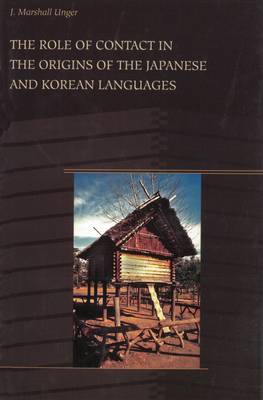
- Retrait gratuit dans votre magasin Club
- 7.000.000 titres dans notre catalogue
- Payer en toute sécurité
- Toujours un magasin près de chez vous
- Retrait gratuit dans votre magasin Club
- 7.000.0000 titres dans notre catalogue
- Payer en toute sécurité
- Toujours un magasin près de chez vous
The Role of Contact in the Origins of the Japanese and Korean Languages
J Marshall Unger
Livre relié | Anglais
73,45 €
+ 146 points
Description
Despite decades of research on the reconstruction of proto-Korean-Japanese (pKJ), some scholars still reject a genetic relationship. This study addresses their doubts in a new way, interpreting comparative linguistic data within a context of material and cultural evidence, much of which has come to light only in recent years.
The weaknesses of the reconstruction, according to J. Marshall Unger, are due to the early date at which pKJ split apart and to lexical material that the pre-Korean and pre-Japanese branches later borrowed from different languages to their north and south, respectively. Unger shows that certain Old Japanese words must have been borrowed from Korean from the fourth century C.E., only a few centuries after the completion of the Yayoi migrations, which brought wet-field rice cultivation to Kyushu from southern Korea. That leaves too short an interval for the growth of two distinct languages by the time they resumed active contact. Hence, concludes Unger, the original separation occurred on the peninsula much earlier, prior to reliance on paddy rice and the rise of metallurgy. Non-Korean elements in ancient peninsular place names were vestiges of pre-Yayoi Japanese language, according to Unger, who questions the assumption that Korean developed exclusively from the language of Silla. He argues instead that the rulers of Koguryo, Paekche, and Silla all spoke varieties of Old Korean, which became the common language of the peninsula as their kingdoms overwhelmed its older culture and vied for dominance. Was the separation so early as to vitiate the hypothesis of a common source language? Unger responds that, while assuming non-relationship obviates difficulties of pKJ reconstruction, it fares worse than the genetic hypothesis in relation to non-linguistic findings, and fails to explain a significant number of grammatical as well as lexical similarities. Though improving the reconstruction of pKJ will be challenging, he argues, the theory of genetic relationship is still the better working hypothesis. The Role of Contact in the Origins of the Japanese and Korean Languages shows how an interdisciplinary approach can shed light on a difficult case in which the separation of two languages lies close to the time horizon of the comparative method.Spécifications
Parties prenantes
- Auteur(s) :
- Editeur:
Contenu
- Nombre de pages :
- 224
- Langue:
- Anglais
Caractéristiques
- EAN:
- 9780824832797
- Date de parution :
- 30-11-08
- Format:
- Livre relié
- Format numérique:
- Genaaid
- Dimensions :
- 157 mm x 229 mm
- Poids :
- 476 g

Les avis
Nous publions uniquement les avis qui respectent les conditions requises. Consultez nos conditions pour les avis.






